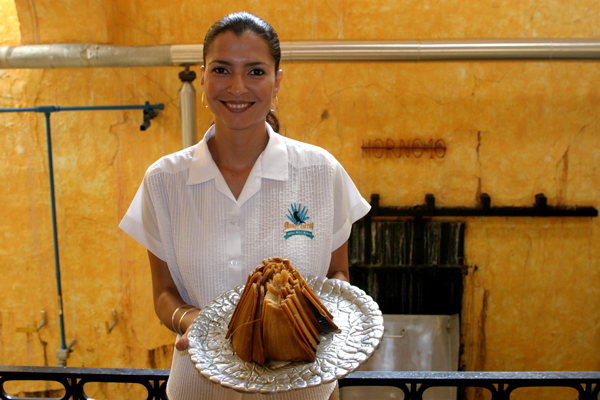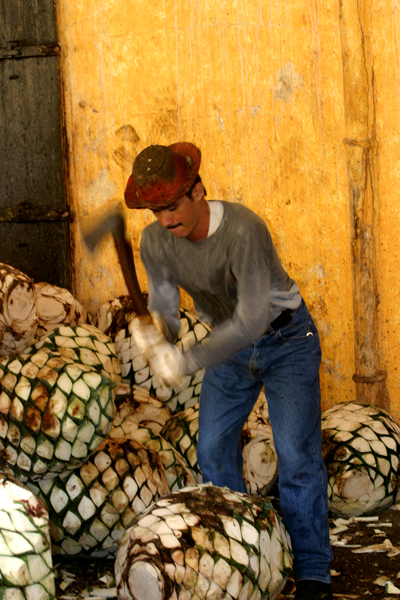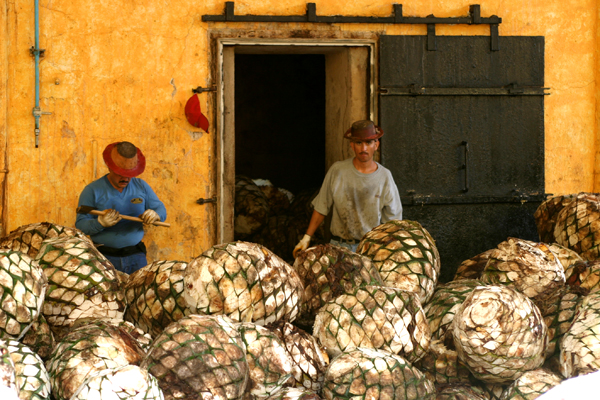So after Ismael Gama and I had tromped around in the agave fields for awhile, we headed for the nearby Cuervo factory which is both very modern and ancient at the same time (it was startling to learn that Cuervo has been around since the mid-1700s—in tact, it’s the oldest continuing business in the Western hemisphere).

A pile of agave hearts at Cuervo. Photo by David Lansing.
What was ancient about it was the process. I stood there, just inside the factory gates, and watched as a truck from the field we’d just been in came in and dumped hundreds and hundreds of just-harvested agave piñas (and just looking at this photo, you can see why they’re called “pineapples”).
Now, in order to make the mash for the distillation of tequila, the first thing you have to do is roast the piñas. Which is about as lo-tech as you can imagine. After the truck has emptied his bed, a couple of guys in Buster Keaton-like leather hats come over and split the hundred-pound piñas in half. Then they lift them on top of their flat-topped hats and carry them to the outdoor ovens, or hornos, piling them 10-feet-high. I mean, this is brutal, back-breaking work. These guys must be stronger than hell (and probably don’t last very long in this job).

Do you think this guy has a tough job? Photo by David Lansing.
When the ovens are full, they slam shut the thick metal door and roast the piñas for a day, maybe a day-and-a-half, at a low temperature—175F to 200F—until it looks (and tastes) a bit like candied yams (in fact, in the town of Tequila, you can buy roasted agave in the markets; locals eat it like candy). I had some and it’s rather tasty. I’m surprised somebody like Thomas Keller hasn’t put it on a menu yet.

Roasted agave, which smells like vanilla and tastes like candied yams. Photo by David Lansing.
After the agave has been roasted, it’s shredded and mashed in big stainless steel tubs (this is where the factory gets more modern; back in the day, they’d dump the roasted agave into a stone pit and a donkey would walk around and around in a circle pulling a large stone wheel to mash the pulp).
This gives you a sort of sweet, honey-colored juice called aguamiel (honey water) which is then combined with yeast and placed in a vat to ferment for a couple of days and then transferred to a copper alambique, just like whisky, where it it distilled at least twice but sometimes three or even four times. The first distillation tastes petrolly and nasty; the third you could almost drink straight (as I’ve said, the more distillations, to refine the rough, low-grade distillate, the better). When you taste that final distillation it is just pure agave. But they’re not done yet.
According to Mexican law, even blanco (white) tequila must be aged for 14-21 days. Not a lot of time, but still, it changes the taste. Reposado (rested) tequilas can sit in oak barrels for up to one year while the anejos are aged anywhere from one to five years. Unlike whisky, tequila doesn’t really get any better sitting around for more than five years (there are some extraordinary exceptions) and it also doesn’t hold up indefinitely in the bottle. In other words, it’s not the sort of thing you want to put away for ten or twenty years; open it and drink it.
Which is exactly what Ismael and I did with a bottle Cuervo Reserva de la Familia, a rare blended tequila that takes several three-year-old anejos and ages them in oak for up to 13 years. Did I say tequila doesn’t hold up very well after five years? Listen, there are exceptions. This is one of them.
A la buena vida.







Recent Comments